Community Health in Horizon City: Assessment, Issue, and Nursing Roles
VerifiedAdded on 2022/11/24
|12
|3540
|212
Report
AI Summary
This report provides a comprehensive analysis of community health in Horizon City, South Australia, with a population of approximately 30,000. It begins with an introduction highlighting prevalent health challenges like diabetes, obesity, and mental health. The core of the report is a psychosocial assessment, examining socio-economic factors such as income, unemployment, education, housing, access to services, and transport, and their impact on the community's health. The report then focuses on type 2 diabetes as a significant health issue in Horizon City, discussing its prevalence, risk factors (lifestyle choices, genetics, and social determinants), and the implications for the community. Finally, the report explores the role of registered nurses in health promotion, specifically through advocacy, enablement, and mediation strategies to manage and address the diabetes challenge in Horizon City. The report uses relevant literature, statistics, and the provided assignment brief to create a detailed analysis of the chosen health issue and the role of healthcare professionals.
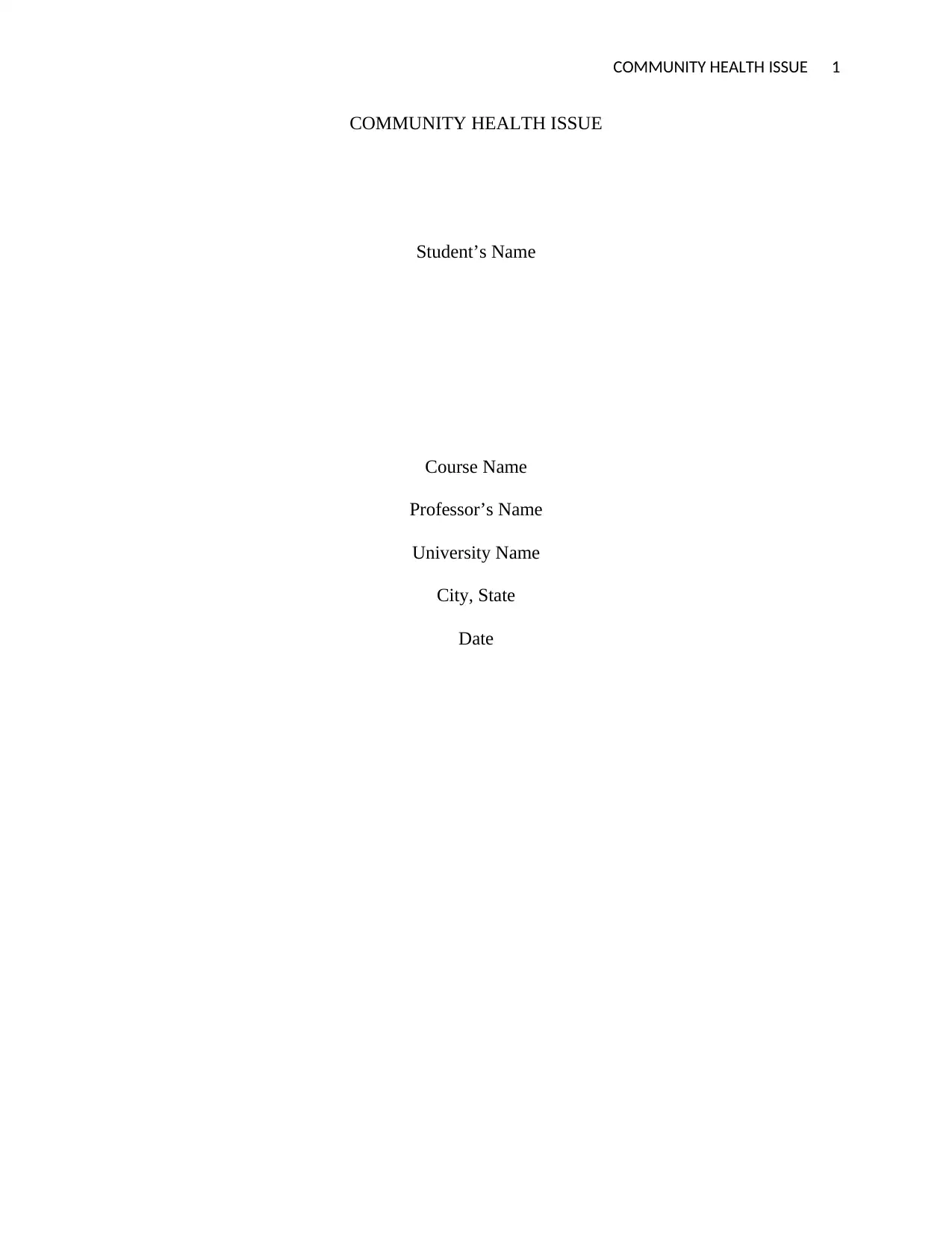
COMMUNITY HEALTH ISSUE 1
COMMUNITY HEALTH ISSUE
Student’s Name
Course Name
Professor’s Name
University Name
City, State
Date
COMMUNITY HEALTH ISSUE
Student’s Name
Course Name
Professor’s Name
University Name
City, State
Date
Paraphrase This Document
Need a fresh take? Get an instant paraphrase of this document with our AI Paraphraser
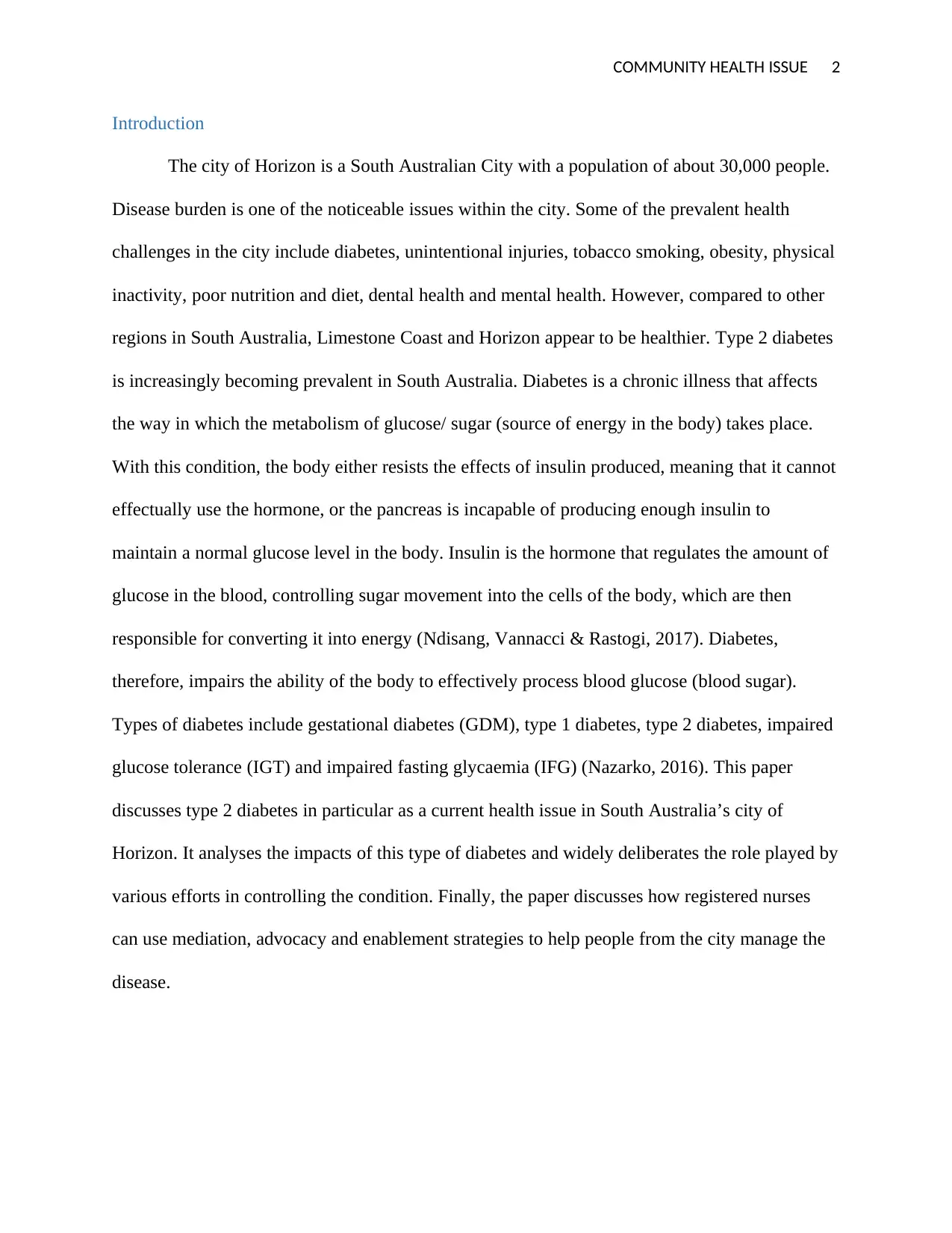
COMMUNITY HEALTH ISSUE 2
Introduction
The city of Horizon is a South Australian City with a population of about 30,000 people.
Disease burden is one of the noticeable issues within the city. Some of the prevalent health
challenges in the city include diabetes, unintentional injuries, tobacco smoking, obesity, physical
inactivity, poor nutrition and diet, dental health and mental health. However, compared to other
regions in South Australia, Limestone Coast and Horizon appear to be healthier. Type 2 diabetes
is increasingly becoming prevalent in South Australia. Diabetes is a chronic illness that affects
the way in which the metabolism of glucose/ sugar (source of energy in the body) takes place.
With this condition, the body either resists the effects of insulin produced, meaning that it cannot
effectually use the hormone, or the pancreas is incapable of producing enough insulin to
maintain a normal glucose level in the body. Insulin is the hormone that regulates the amount of
glucose in the blood, controlling sugar movement into the cells of the body, which are then
responsible for converting it into energy (Ndisang, Vannacci & Rastogi, 2017). Diabetes,
therefore, impairs the ability of the body to effectively process blood glucose (blood sugar).
Types of diabetes include gestational diabetes (GDM), type 1 diabetes, type 2 diabetes, impaired
glucose tolerance (IGT) and impaired fasting glycaemia (IFG) (Nazarko, 2016). This paper
discusses type 2 diabetes in particular as a current health issue in South Australia’s city of
Horizon. It analyses the impacts of this type of diabetes and widely deliberates the role played by
various efforts in controlling the condition. Finally, the paper discusses how registered nurses
can use mediation, advocacy and enablement strategies to help people from the city manage the
disease.
Introduction
The city of Horizon is a South Australian City with a population of about 30,000 people.
Disease burden is one of the noticeable issues within the city. Some of the prevalent health
challenges in the city include diabetes, unintentional injuries, tobacco smoking, obesity, physical
inactivity, poor nutrition and diet, dental health and mental health. However, compared to other
regions in South Australia, Limestone Coast and Horizon appear to be healthier. Type 2 diabetes
is increasingly becoming prevalent in South Australia. Diabetes is a chronic illness that affects
the way in which the metabolism of glucose/ sugar (source of energy in the body) takes place.
With this condition, the body either resists the effects of insulin produced, meaning that it cannot
effectually use the hormone, or the pancreas is incapable of producing enough insulin to
maintain a normal glucose level in the body. Insulin is the hormone that regulates the amount of
glucose in the blood, controlling sugar movement into the cells of the body, which are then
responsible for converting it into energy (Ndisang, Vannacci & Rastogi, 2017). Diabetes,
therefore, impairs the ability of the body to effectively process blood glucose (blood sugar).
Types of diabetes include gestational diabetes (GDM), type 1 diabetes, type 2 diabetes, impaired
glucose tolerance (IGT) and impaired fasting glycaemia (IFG) (Nazarko, 2016). This paper
discusses type 2 diabetes in particular as a current health issue in South Australia’s city of
Horizon. It analyses the impacts of this type of diabetes and widely deliberates the role played by
various efforts in controlling the condition. Finally, the paper discusses how registered nurses
can use mediation, advocacy and enablement strategies to help people from the city manage the
disease.
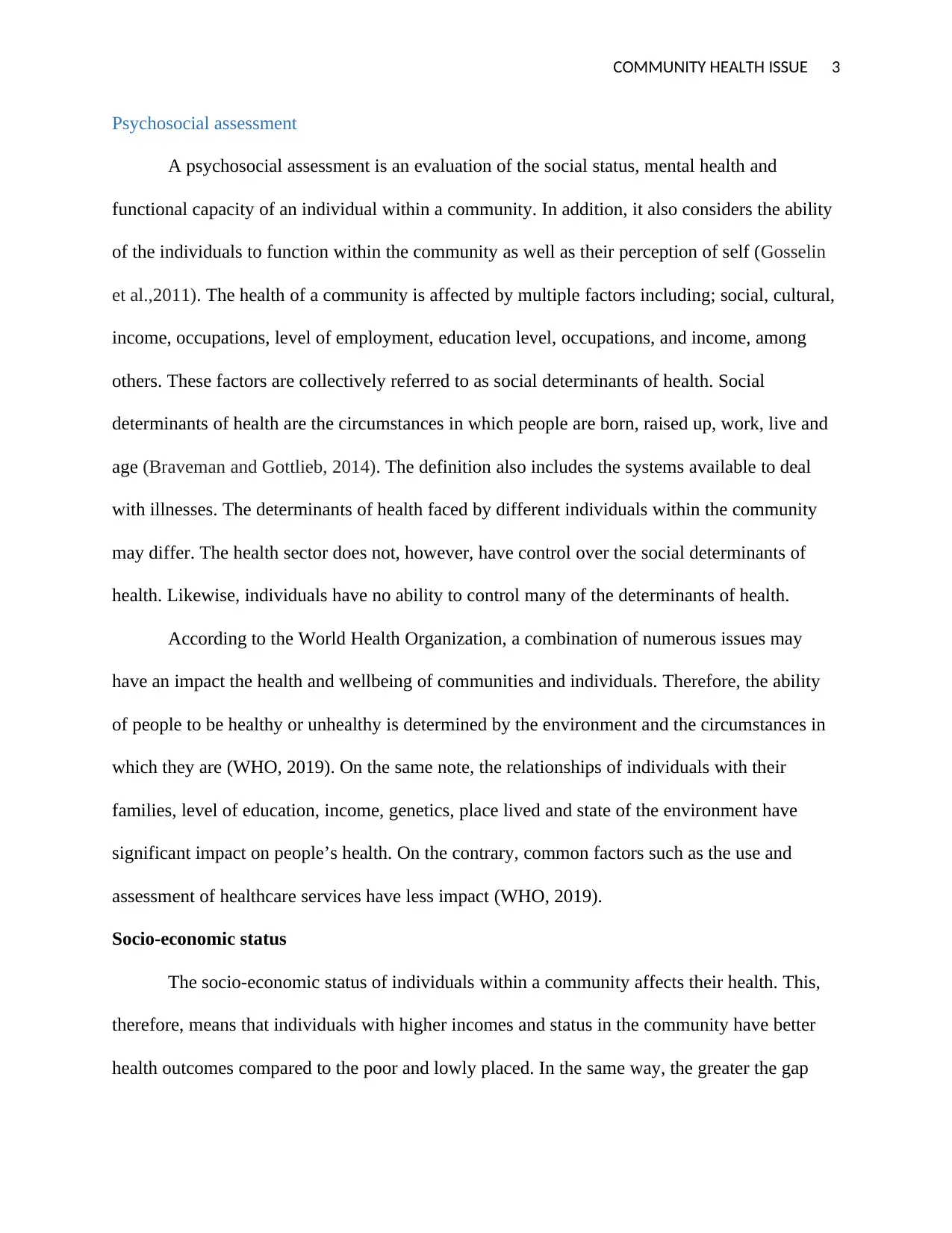
COMMUNITY HEALTH ISSUE 3
Psychosocial assessment
A psychosocial assessment is an evaluation of the social status, mental health and
functional capacity of an individual within a community. In addition, it also considers the ability
of the individuals to function within the community as well as their perception of self (Gosselin
et al.,2011). The health of a community is affected by multiple factors including; social, cultural,
income, occupations, level of employment, education level, occupations, and income, among
others. These factors are collectively referred to as social determinants of health. Social
determinants of health are the circumstances in which people are born, raised up, work, live and
age (Braveman and Gottlieb, 2014). The definition also includes the systems available to deal
with illnesses. The determinants of health faced by different individuals within the community
may differ. The health sector does not, however, have control over the social determinants of
health. Likewise, individuals have no ability to control many of the determinants of health.
According to the World Health Organization, a combination of numerous issues may
have an impact the health and wellbeing of communities and individuals. Therefore, the ability
of people to be healthy or unhealthy is determined by the environment and the circumstances in
which they are (WHO, 2019). On the same note, the relationships of individuals with their
families, level of education, income, genetics, place lived and state of the environment have
significant impact on people’s health. On the contrary, common factors such as the use and
assessment of healthcare services have less impact (WHO, 2019).
Socio-economic status
The socio-economic status of individuals within a community affects their health. This,
therefore, means that individuals with higher incomes and status in the community have better
health outcomes compared to the poor and lowly placed. In the same way, the greater the gap
Psychosocial assessment
A psychosocial assessment is an evaluation of the social status, mental health and
functional capacity of an individual within a community. In addition, it also considers the ability
of the individuals to function within the community as well as their perception of self (Gosselin
et al.,2011). The health of a community is affected by multiple factors including; social, cultural,
income, occupations, level of employment, education level, occupations, and income, among
others. These factors are collectively referred to as social determinants of health. Social
determinants of health are the circumstances in which people are born, raised up, work, live and
age (Braveman and Gottlieb, 2014). The definition also includes the systems available to deal
with illnesses. The determinants of health faced by different individuals within the community
may differ. The health sector does not, however, have control over the social determinants of
health. Likewise, individuals have no ability to control many of the determinants of health.
According to the World Health Organization, a combination of numerous issues may
have an impact the health and wellbeing of communities and individuals. Therefore, the ability
of people to be healthy or unhealthy is determined by the environment and the circumstances in
which they are (WHO, 2019). On the same note, the relationships of individuals with their
families, level of education, income, genetics, place lived and state of the environment have
significant impact on people’s health. On the contrary, common factors such as the use and
assessment of healthcare services have less impact (WHO, 2019).
Socio-economic status
The socio-economic status of individuals within a community affects their health. This,
therefore, means that individuals with higher incomes and status in the community have better
health outcomes compared to the poor and lowly placed. In the same way, the greater the gap
⊘ This is a preview!⊘
Do you want full access?
Subscribe today to unlock all pages.

Trusted by 1+ million students worldwide
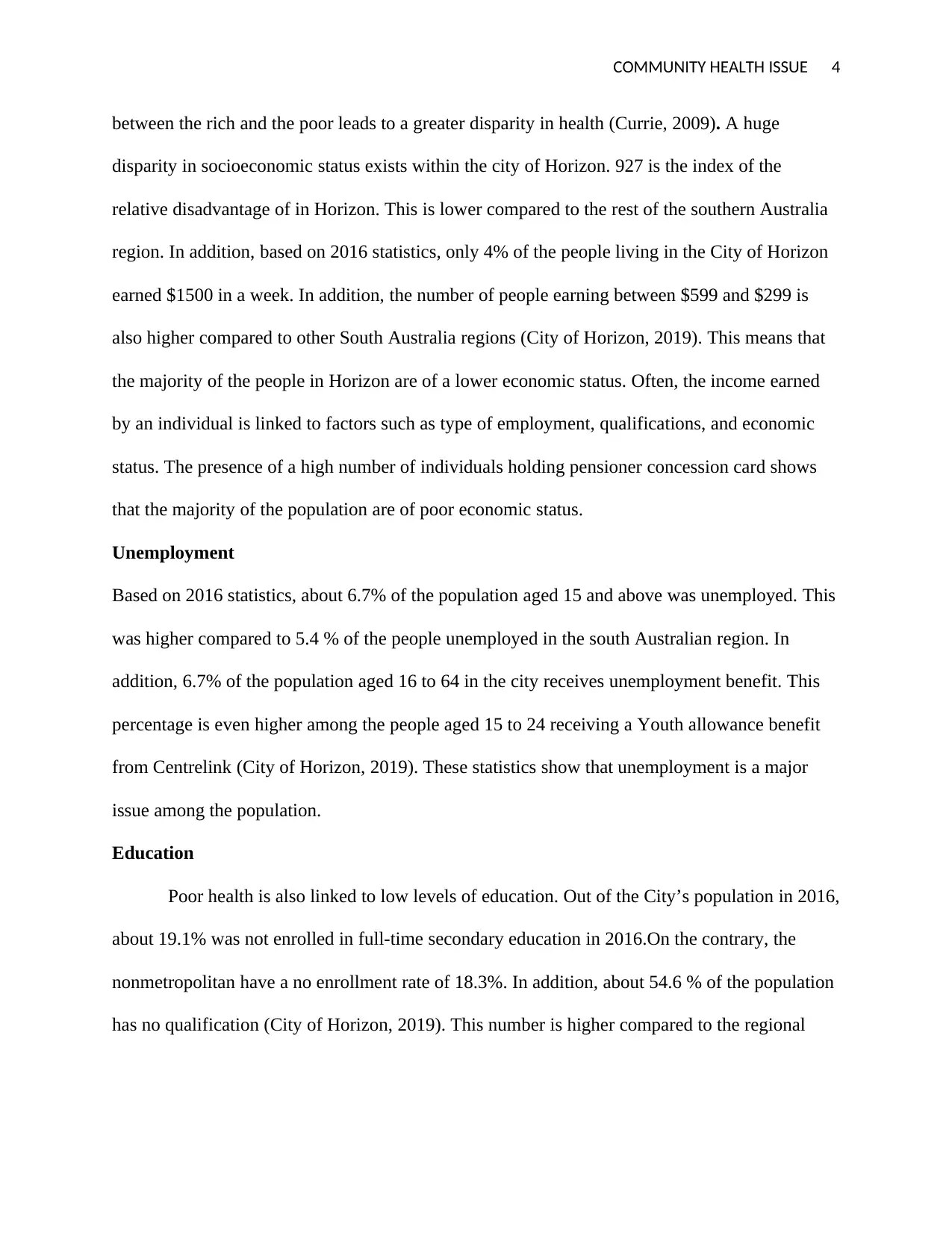
COMMUNITY HEALTH ISSUE 4
between the rich and the poor leads to a greater disparity in health (Currie, 2009). A huge
disparity in socioeconomic status exists within the city of Horizon. 927 is the index of the
relative disadvantage of in Horizon. This is lower compared to the rest of the southern Australia
region. In addition, based on 2016 statistics, only 4% of the people living in the City of Horizon
earned $1500 in a week. In addition, the number of people earning between $599 and $299 is
also higher compared to other South Australia regions (City of Horizon, 2019). This means that
the majority of the people in Horizon are of a lower economic status. Often, the income earned
by an individual is linked to factors such as type of employment, qualifications, and economic
status. The presence of a high number of individuals holding pensioner concession card shows
that the majority of the population are of poor economic status.
Unemployment
Based on 2016 statistics, about 6.7% of the population aged 15 and above was unemployed. This
was higher compared to 5.4 % of the people unemployed in the south Australian region. In
addition, 6.7% of the population aged 16 to 64 in the city receives unemployment benefit. This
percentage is even higher among the people aged 15 to 24 receiving a Youth allowance benefit
from Centrelink (City of Horizon, 2019). These statistics show that unemployment is a major
issue among the population.
Education
Poor health is also linked to low levels of education. Out of the City’s population in 2016,
about 19.1% was not enrolled in full-time secondary education in 2016.On the contrary, the
nonmetropolitan have a no enrollment rate of 18.3%. In addition, about 54.6 % of the population
has no qualification (City of Horizon, 2019). This number is higher compared to the regional
between the rich and the poor leads to a greater disparity in health (Currie, 2009). A huge
disparity in socioeconomic status exists within the city of Horizon. 927 is the index of the
relative disadvantage of in Horizon. This is lower compared to the rest of the southern Australia
region. In addition, based on 2016 statistics, only 4% of the people living in the City of Horizon
earned $1500 in a week. In addition, the number of people earning between $599 and $299 is
also higher compared to other South Australia regions (City of Horizon, 2019). This means that
the majority of the people in Horizon are of a lower economic status. Often, the income earned
by an individual is linked to factors such as type of employment, qualifications, and economic
status. The presence of a high number of individuals holding pensioner concession card shows
that the majority of the population are of poor economic status.
Unemployment
Based on 2016 statistics, about 6.7% of the population aged 15 and above was unemployed. This
was higher compared to 5.4 % of the people unemployed in the south Australian region. In
addition, 6.7% of the population aged 16 to 64 in the city receives unemployment benefit. This
percentage is even higher among the people aged 15 to 24 receiving a Youth allowance benefit
from Centrelink (City of Horizon, 2019). These statistics show that unemployment is a major
issue among the population.
Education
Poor health is also linked to low levels of education. Out of the City’s population in 2016,
about 19.1% was not enrolled in full-time secondary education in 2016.On the contrary, the
nonmetropolitan have a no enrollment rate of 18.3%. In addition, about 54.6 % of the population
has no qualification (City of Horizon, 2019). This number is higher compared to the regional
Paraphrase This Document
Need a fresh take? Get an instant paraphrase of this document with our AI Paraphraser
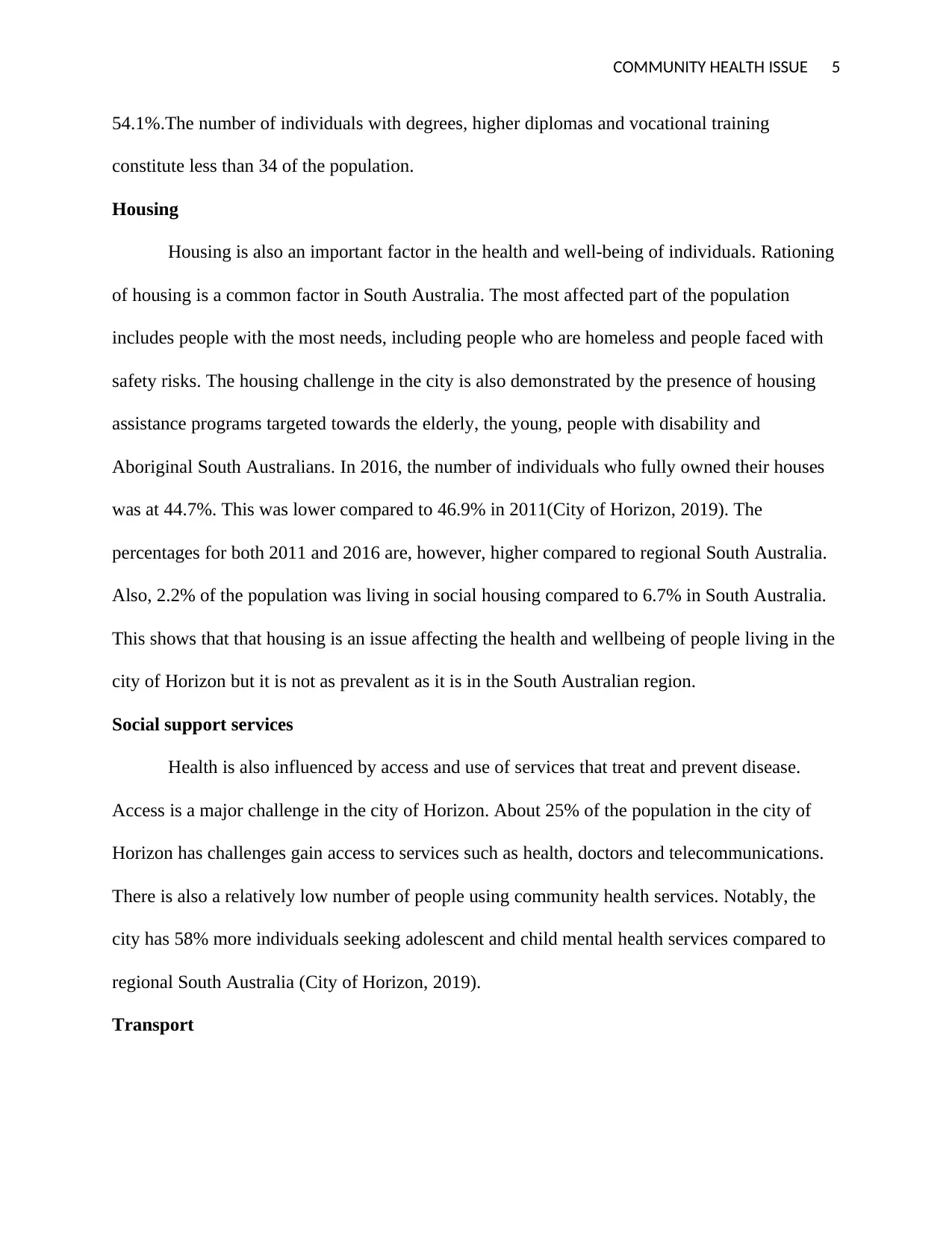
COMMUNITY HEALTH ISSUE 5
54.1%.The number of individuals with degrees, higher diplomas and vocational training
constitute less than 34 of the population.
Housing
Housing is also an important factor in the health and well-being of individuals. Rationing
of housing is a common factor in South Australia. The most affected part of the population
includes people with the most needs, including people who are homeless and people faced with
safety risks. The housing challenge in the city is also demonstrated by the presence of housing
assistance programs targeted towards the elderly, the young, people with disability and
Aboriginal South Australians. In 2016, the number of individuals who fully owned their houses
was at 44.7%. This was lower compared to 46.9% in 2011(City of Horizon, 2019). The
percentages for both 2011 and 2016 are, however, higher compared to regional South Australia.
Also, 2.2% of the population was living in social housing compared to 6.7% in South Australia.
This shows that that housing is an issue affecting the health and wellbeing of people living in the
city of Horizon but it is not as prevalent as it is in the South Australian region.
Social support services
Health is also influenced by access and use of services that treat and prevent disease.
Access is a major challenge in the city of Horizon. About 25% of the population in the city of
Horizon has challenges gain access to services such as health, doctors and telecommunications.
There is also a relatively low number of people using community health services. Notably, the
city has 58% more individuals seeking adolescent and child mental health services compared to
regional South Australia (City of Horizon, 2019).
Transport
54.1%.The number of individuals with degrees, higher diplomas and vocational training
constitute less than 34 of the population.
Housing
Housing is also an important factor in the health and well-being of individuals. Rationing
of housing is a common factor in South Australia. The most affected part of the population
includes people with the most needs, including people who are homeless and people faced with
safety risks. The housing challenge in the city is also demonstrated by the presence of housing
assistance programs targeted towards the elderly, the young, people with disability and
Aboriginal South Australians. In 2016, the number of individuals who fully owned their houses
was at 44.7%. This was lower compared to 46.9% in 2011(City of Horizon, 2019). The
percentages for both 2011 and 2016 are, however, higher compared to regional South Australia.
Also, 2.2% of the population was living in social housing compared to 6.7% in South Australia.
This shows that that housing is an issue affecting the health and wellbeing of people living in the
city of Horizon but it is not as prevalent as it is in the South Australian region.
Social support services
Health is also influenced by access and use of services that treat and prevent disease.
Access is a major challenge in the city of Horizon. About 25% of the population in the city of
Horizon has challenges gain access to services such as health, doctors and telecommunications.
There is also a relatively low number of people using community health services. Notably, the
city has 58% more individuals seeking adolescent and child mental health services compared to
regional South Australia (City of Horizon, 2019).
Transport
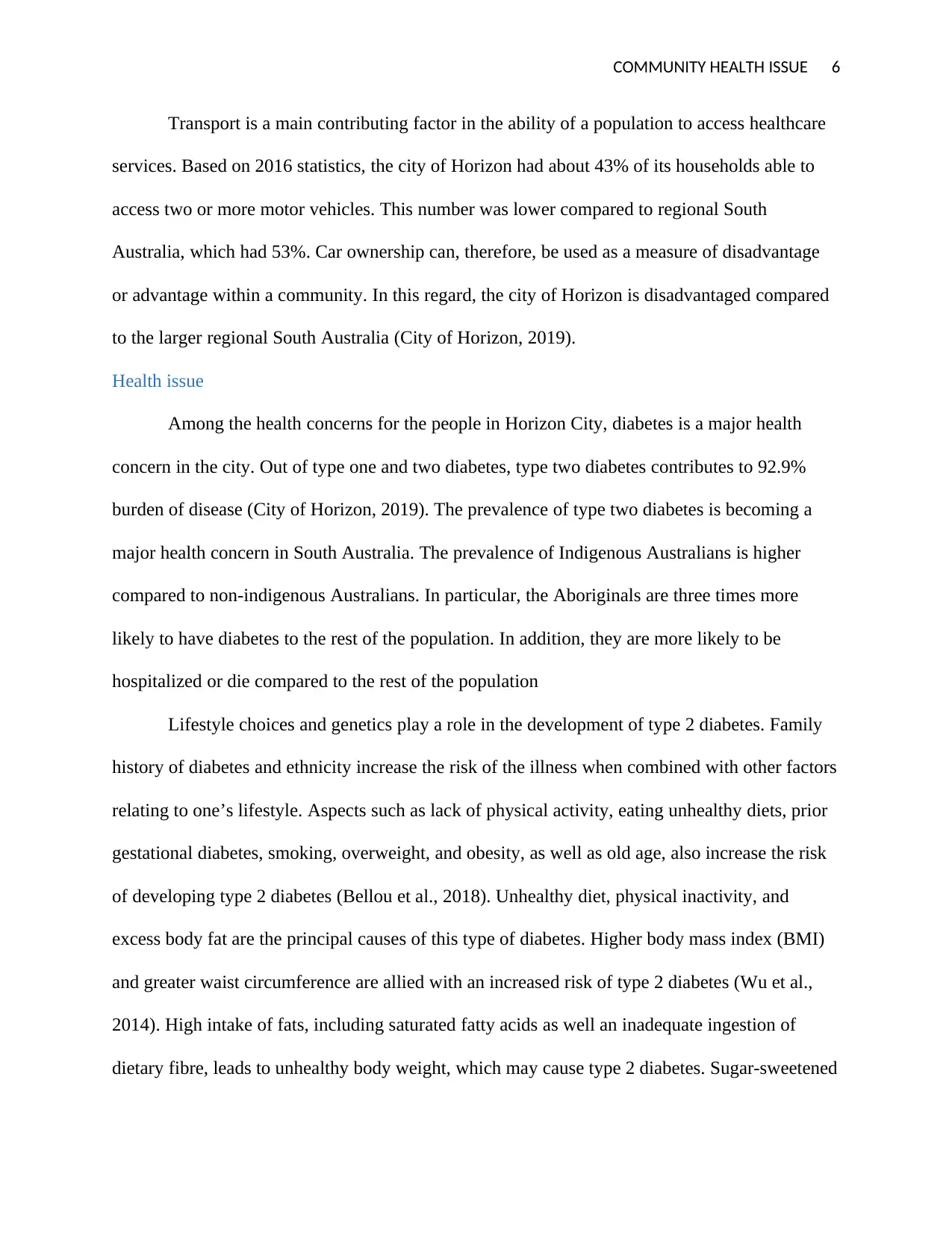
COMMUNITY HEALTH ISSUE 6
Transport is a main contributing factor in the ability of a population to access healthcare
services. Based on 2016 statistics, the city of Horizon had about 43% of its households able to
access two or more motor vehicles. This number was lower compared to regional South
Australia, which had 53%. Car ownership can, therefore, be used as a measure of disadvantage
or advantage within a community. In this regard, the city of Horizon is disadvantaged compared
to the larger regional South Australia (City of Horizon, 2019).
Health issue
Among the health concerns for the people in Horizon City, diabetes is a major health
concern in the city. Out of type one and two diabetes, type two diabetes contributes to 92.9%
burden of disease (City of Horizon, 2019). The prevalence of type two diabetes is becoming a
major health concern in South Australia. The prevalence of Indigenous Australians is higher
compared to non-indigenous Australians. In particular, the Aboriginals are three times more
likely to have diabetes to the rest of the population. In addition, they are more likely to be
hospitalized or die compared to the rest of the population
Lifestyle choices and genetics play a role in the development of type 2 diabetes. Family
history of diabetes and ethnicity increase the risk of the illness when combined with other factors
relating to one’s lifestyle. Aspects such as lack of physical activity, eating unhealthy diets, prior
gestational diabetes, smoking, overweight, and obesity, as well as old age, also increase the risk
of developing type 2 diabetes (Bellou et al., 2018). Unhealthy diet, physical inactivity, and
excess body fat are the principal causes of this type of diabetes. Higher body mass index (BMI)
and greater waist circumference are allied with an increased risk of type 2 diabetes (Wu et al.,
2014). High intake of fats, including saturated fatty acids as well an inadequate ingestion of
dietary fibre, leads to unhealthy body weight, which may cause type 2 diabetes. Sugar-sweetened
Transport is a main contributing factor in the ability of a population to access healthcare
services. Based on 2016 statistics, the city of Horizon had about 43% of its households able to
access two or more motor vehicles. This number was lower compared to regional South
Australia, which had 53%. Car ownership can, therefore, be used as a measure of disadvantage
or advantage within a community. In this regard, the city of Horizon is disadvantaged compared
to the larger regional South Australia (City of Horizon, 2019).
Health issue
Among the health concerns for the people in Horizon City, diabetes is a major health
concern in the city. Out of type one and two diabetes, type two diabetes contributes to 92.9%
burden of disease (City of Horizon, 2019). The prevalence of type two diabetes is becoming a
major health concern in South Australia. The prevalence of Indigenous Australians is higher
compared to non-indigenous Australians. In particular, the Aboriginals are three times more
likely to have diabetes to the rest of the population. In addition, they are more likely to be
hospitalized or die compared to the rest of the population
Lifestyle choices and genetics play a role in the development of type 2 diabetes. Family
history of diabetes and ethnicity increase the risk of the illness when combined with other factors
relating to one’s lifestyle. Aspects such as lack of physical activity, eating unhealthy diets, prior
gestational diabetes, smoking, overweight, and obesity, as well as old age, also increase the risk
of developing type 2 diabetes (Bellou et al., 2018). Unhealthy diet, physical inactivity, and
excess body fat are the principal causes of this type of diabetes. Higher body mass index (BMI)
and greater waist circumference are allied with an increased risk of type 2 diabetes (Wu et al.,
2014). High intake of fats, including saturated fatty acids as well an inadequate ingestion of
dietary fibre, leads to unhealthy body weight, which may cause type 2 diabetes. Sugar-sweetened
⊘ This is a preview!⊘
Do you want full access?
Subscribe today to unlock all pages.

Trusted by 1+ million students worldwide
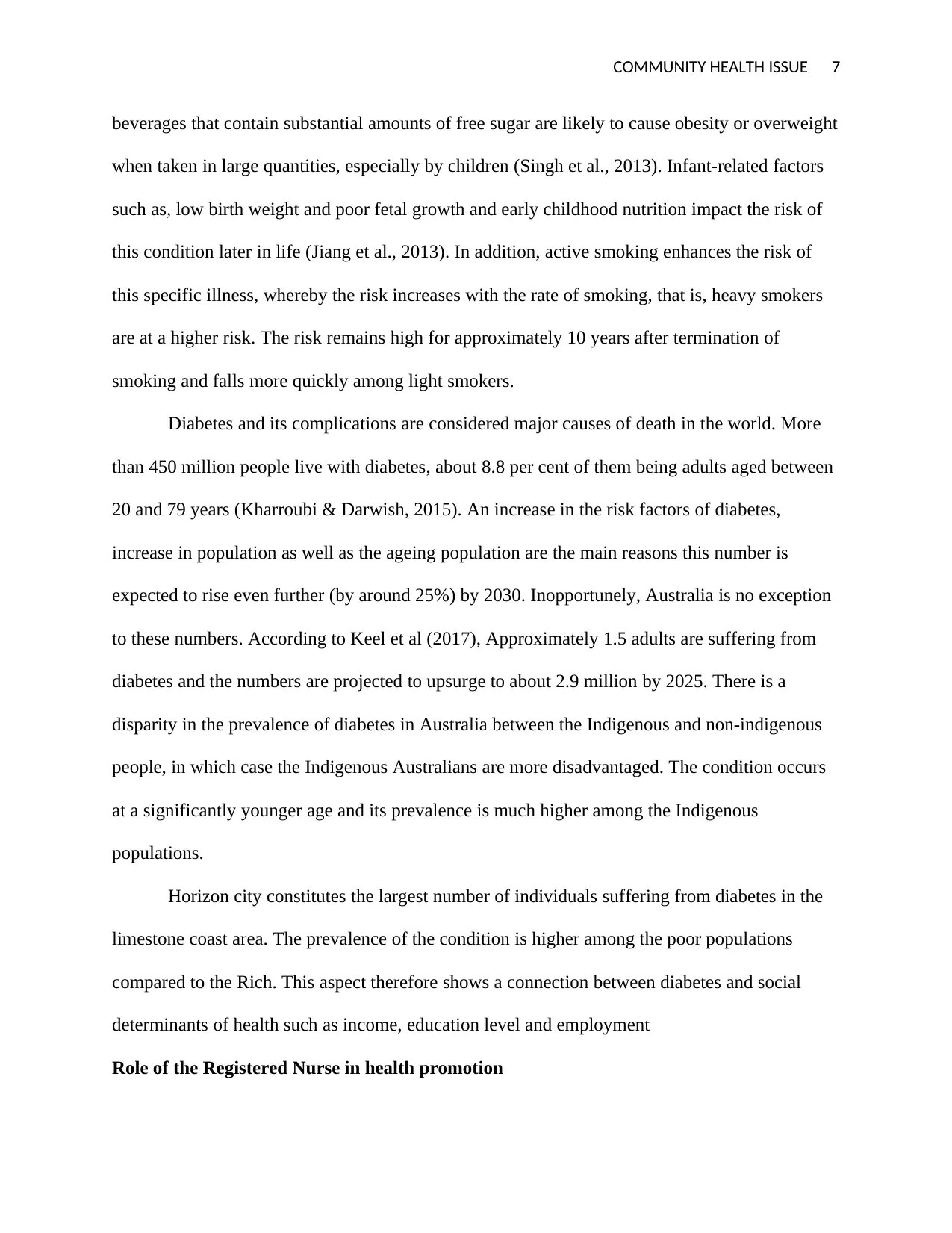
COMMUNITY HEALTH ISSUE 7
beverages that contain substantial amounts of free sugar are likely to cause obesity or overweight
when taken in large quantities, especially by children (Singh et al., 2013). Infant-related factors
such as, low birth weight and poor fetal growth and early childhood nutrition impact the risk of
this condition later in life (Jiang et al., 2013). In addition, active smoking enhances the risk of
this specific illness, whereby the risk increases with the rate of smoking, that is, heavy smokers
are at a higher risk. The risk remains high for approximately 10 years after termination of
smoking and falls more quickly among light smokers.
Diabetes and its complications are considered major causes of death in the world. More
than 450 million people live with diabetes, about 8.8 per cent of them being adults aged between
20 and 79 years (Kharroubi & Darwish, 2015). An increase in the risk factors of diabetes,
increase in population as well as the ageing population are the main reasons this number is
expected to rise even further (by around 25%) by 2030. Inopportunely, Australia is no exception
to these numbers. According to Keel et al (2017), Approximately 1.5 adults are suffering from
diabetes and the numbers are projected to upsurge to about 2.9 million by 2025. There is a
disparity in the prevalence of diabetes in Australia between the Indigenous and non-indigenous
people, in which case the Indigenous Australians are more disadvantaged. The condition occurs
at a significantly younger age and its prevalence is much higher among the Indigenous
populations.
Horizon city constitutes the largest number of individuals suffering from diabetes in the
limestone coast area. The prevalence of the condition is higher among the poor populations
compared to the Rich. This aspect therefore shows a connection between diabetes and social
determinants of health such as income, education level and employment
Role of the Registered Nurse in health promotion
beverages that contain substantial amounts of free sugar are likely to cause obesity or overweight
when taken in large quantities, especially by children (Singh et al., 2013). Infant-related factors
such as, low birth weight and poor fetal growth and early childhood nutrition impact the risk of
this condition later in life (Jiang et al., 2013). In addition, active smoking enhances the risk of
this specific illness, whereby the risk increases with the rate of smoking, that is, heavy smokers
are at a higher risk. The risk remains high for approximately 10 years after termination of
smoking and falls more quickly among light smokers.
Diabetes and its complications are considered major causes of death in the world. More
than 450 million people live with diabetes, about 8.8 per cent of them being adults aged between
20 and 79 years (Kharroubi & Darwish, 2015). An increase in the risk factors of diabetes,
increase in population as well as the ageing population are the main reasons this number is
expected to rise even further (by around 25%) by 2030. Inopportunely, Australia is no exception
to these numbers. According to Keel et al (2017), Approximately 1.5 adults are suffering from
diabetes and the numbers are projected to upsurge to about 2.9 million by 2025. There is a
disparity in the prevalence of diabetes in Australia between the Indigenous and non-indigenous
people, in which case the Indigenous Australians are more disadvantaged. The condition occurs
at a significantly younger age and its prevalence is much higher among the Indigenous
populations.
Horizon city constitutes the largest number of individuals suffering from diabetes in the
limestone coast area. The prevalence of the condition is higher among the poor populations
compared to the Rich. This aspect therefore shows a connection between diabetes and social
determinants of health such as income, education level and employment
Role of the Registered Nurse in health promotion
Paraphrase This Document
Need a fresh take? Get an instant paraphrase of this document with our AI Paraphraser
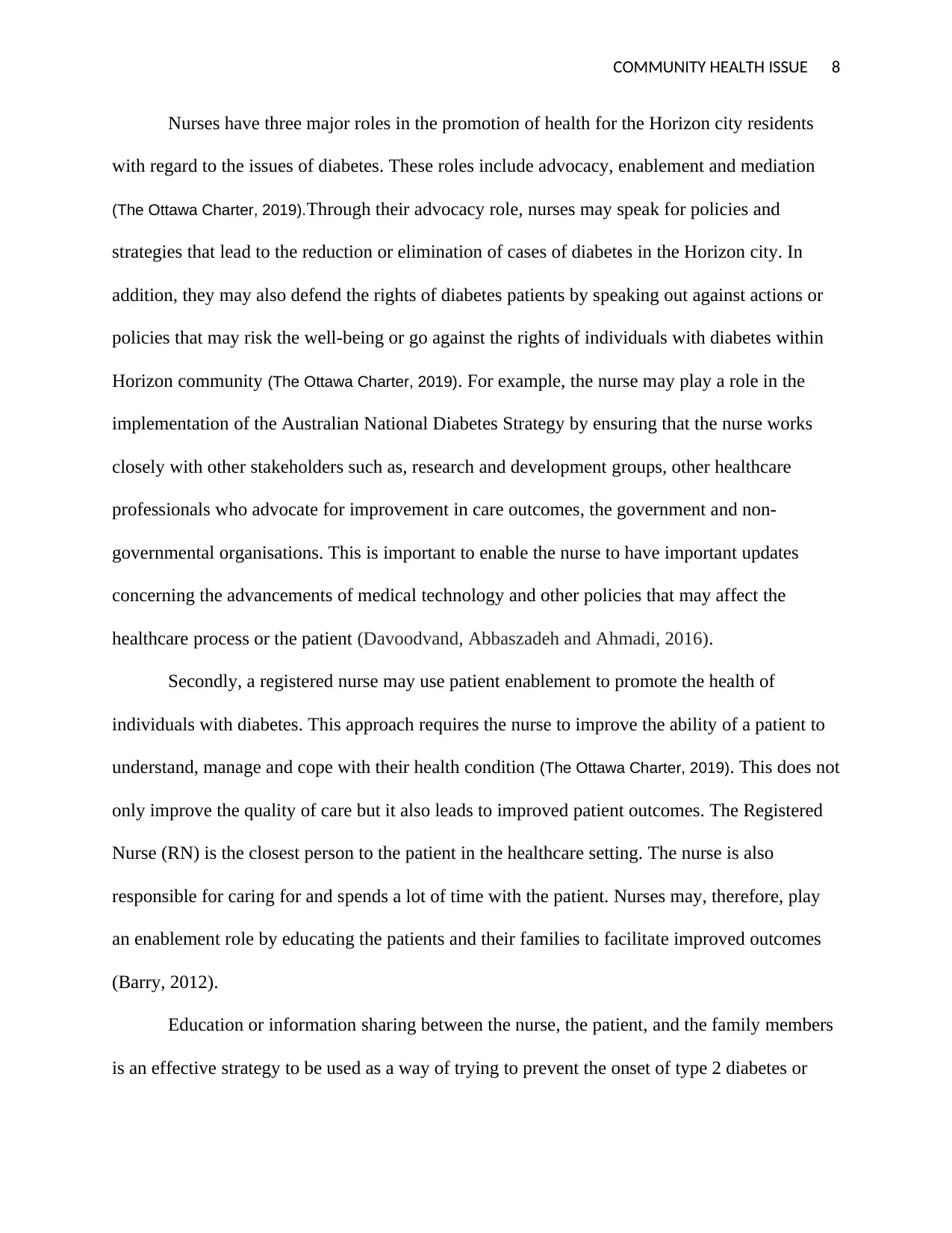
COMMUNITY HEALTH ISSUE 8
Nurses have three major roles in the promotion of health for the Horizon city residents
with regard to the issues of diabetes. These roles include advocacy, enablement and mediation
(The Ottawa Charter, 2019).Through their advocacy role, nurses may speak for policies and
strategies that lead to the reduction or elimination of cases of diabetes in the Horizon city. In
addition, they may also defend the rights of diabetes patients by speaking out against actions or
policies that may risk the well-being or go against the rights of individuals with diabetes within
Horizon community (The Ottawa Charter, 2019). For example, the nurse may play a role in the
implementation of the Australian National Diabetes Strategy by ensuring that the nurse works
closely with other stakeholders such as, research and development groups, other healthcare
professionals who advocate for improvement in care outcomes, the government and non-
governmental organisations. This is important to enable the nurse to have important updates
concerning the advancements of medical technology and other policies that may affect the
healthcare process or the patient (Davoodvand, Abbaszadeh and Ahmadi, 2016).
Secondly, a registered nurse may use patient enablement to promote the health of
individuals with diabetes. This approach requires the nurse to improve the ability of a patient to
understand, manage and cope with their health condition (The Ottawa Charter, 2019). This does not
only improve the quality of care but it also leads to improved patient outcomes. The Registered
Nurse (RN) is the closest person to the patient in the healthcare setting. The nurse is also
responsible for caring for and spends a lot of time with the patient. Nurses may, therefore, play
an enablement role by educating the patients and their families to facilitate improved outcomes
(Barry, 2012).
Education or information sharing between the nurse, the patient, and the family members
is an effective strategy to be used as a way of trying to prevent the onset of type 2 diabetes or
Nurses have three major roles in the promotion of health for the Horizon city residents
with regard to the issues of diabetes. These roles include advocacy, enablement and mediation
(The Ottawa Charter, 2019).Through their advocacy role, nurses may speak for policies and
strategies that lead to the reduction or elimination of cases of diabetes in the Horizon city. In
addition, they may also defend the rights of diabetes patients by speaking out against actions or
policies that may risk the well-being or go against the rights of individuals with diabetes within
Horizon community (The Ottawa Charter, 2019). For example, the nurse may play a role in the
implementation of the Australian National Diabetes Strategy by ensuring that the nurse works
closely with other stakeholders such as, research and development groups, other healthcare
professionals who advocate for improvement in care outcomes, the government and non-
governmental organisations. This is important to enable the nurse to have important updates
concerning the advancements of medical technology and other policies that may affect the
healthcare process or the patient (Davoodvand, Abbaszadeh and Ahmadi, 2016).
Secondly, a registered nurse may use patient enablement to promote the health of
individuals with diabetes. This approach requires the nurse to improve the ability of a patient to
understand, manage and cope with their health condition (The Ottawa Charter, 2019). This does not
only improve the quality of care but it also leads to improved patient outcomes. The Registered
Nurse (RN) is the closest person to the patient in the healthcare setting. The nurse is also
responsible for caring for and spends a lot of time with the patient. Nurses may, therefore, play
an enablement role by educating the patients and their families to facilitate improved outcomes
(Barry, 2012).
Education or information sharing between the nurse, the patient, and the family members
is an effective strategy to be used as a way of trying to prevent the onset of type 2 diabetes or
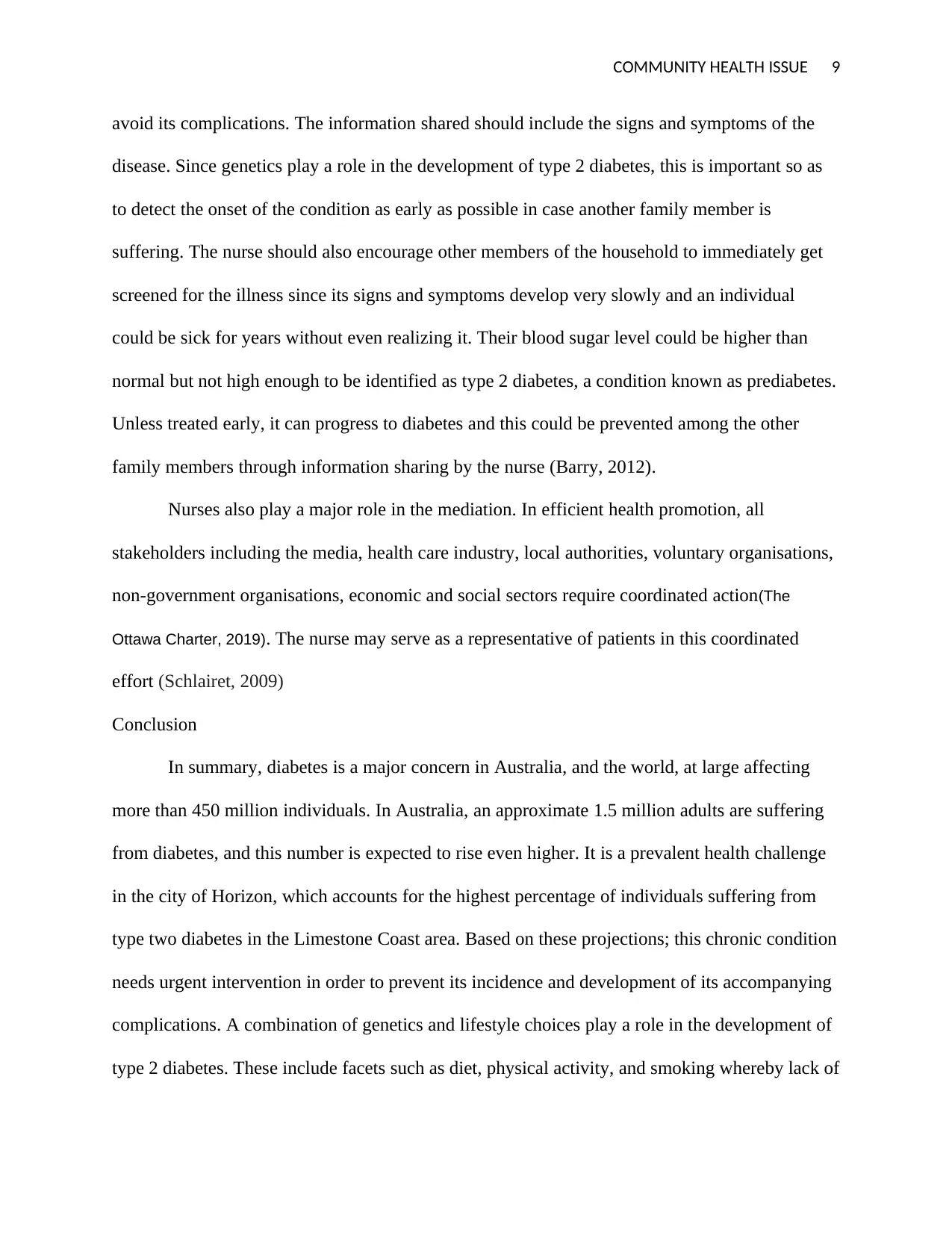
COMMUNITY HEALTH ISSUE 9
avoid its complications. The information shared should include the signs and symptoms of the
disease. Since genetics play a role in the development of type 2 diabetes, this is important so as
to detect the onset of the condition as early as possible in case another family member is
suffering. The nurse should also encourage other members of the household to immediately get
screened for the illness since its signs and symptoms develop very slowly and an individual
could be sick for years without even realizing it. Their blood sugar level could be higher than
normal but not high enough to be identified as type 2 diabetes, a condition known as prediabetes.
Unless treated early, it can progress to diabetes and this could be prevented among the other
family members through information sharing by the nurse (Barry, 2012).
Nurses also play a major role in the mediation. In efficient health promotion, all
stakeholders including the media, health care industry, local authorities, voluntary organisations,
non-government organisations, economic and social sectors require coordinated action(The
Ottawa Charter, 2019). The nurse may serve as a representative of patients in this coordinated
effort (Schlairet, 2009)
Conclusion
In summary, diabetes is a major concern in Australia, and the world, at large affecting
more than 450 million individuals. In Australia, an approximate 1.5 million adults are suffering
from diabetes, and this number is expected to rise even higher. It is a prevalent health challenge
in the city of Horizon, which accounts for the highest percentage of individuals suffering from
type two diabetes in the Limestone Coast area. Based on these projections; this chronic condition
needs urgent intervention in order to prevent its incidence and development of its accompanying
complications. A combination of genetics and lifestyle choices play a role in the development of
type 2 diabetes. These include facets such as diet, physical activity, and smoking whereby lack of
avoid its complications. The information shared should include the signs and symptoms of the
disease. Since genetics play a role in the development of type 2 diabetes, this is important so as
to detect the onset of the condition as early as possible in case another family member is
suffering. The nurse should also encourage other members of the household to immediately get
screened for the illness since its signs and symptoms develop very slowly and an individual
could be sick for years without even realizing it. Their blood sugar level could be higher than
normal but not high enough to be identified as type 2 diabetes, a condition known as prediabetes.
Unless treated early, it can progress to diabetes and this could be prevented among the other
family members through information sharing by the nurse (Barry, 2012).
Nurses also play a major role in the mediation. In efficient health promotion, all
stakeholders including the media, health care industry, local authorities, voluntary organisations,
non-government organisations, economic and social sectors require coordinated action(The
Ottawa Charter, 2019). The nurse may serve as a representative of patients in this coordinated
effort (Schlairet, 2009)
Conclusion
In summary, diabetes is a major concern in Australia, and the world, at large affecting
more than 450 million individuals. In Australia, an approximate 1.5 million adults are suffering
from diabetes, and this number is expected to rise even higher. It is a prevalent health challenge
in the city of Horizon, which accounts for the highest percentage of individuals suffering from
type two diabetes in the Limestone Coast area. Based on these projections; this chronic condition
needs urgent intervention in order to prevent its incidence and development of its accompanying
complications. A combination of genetics and lifestyle choices play a role in the development of
type 2 diabetes. These include facets such as diet, physical activity, and smoking whereby lack of
⊘ This is a preview!⊘
Do you want full access?
Subscribe today to unlock all pages.

Trusted by 1+ million students worldwide
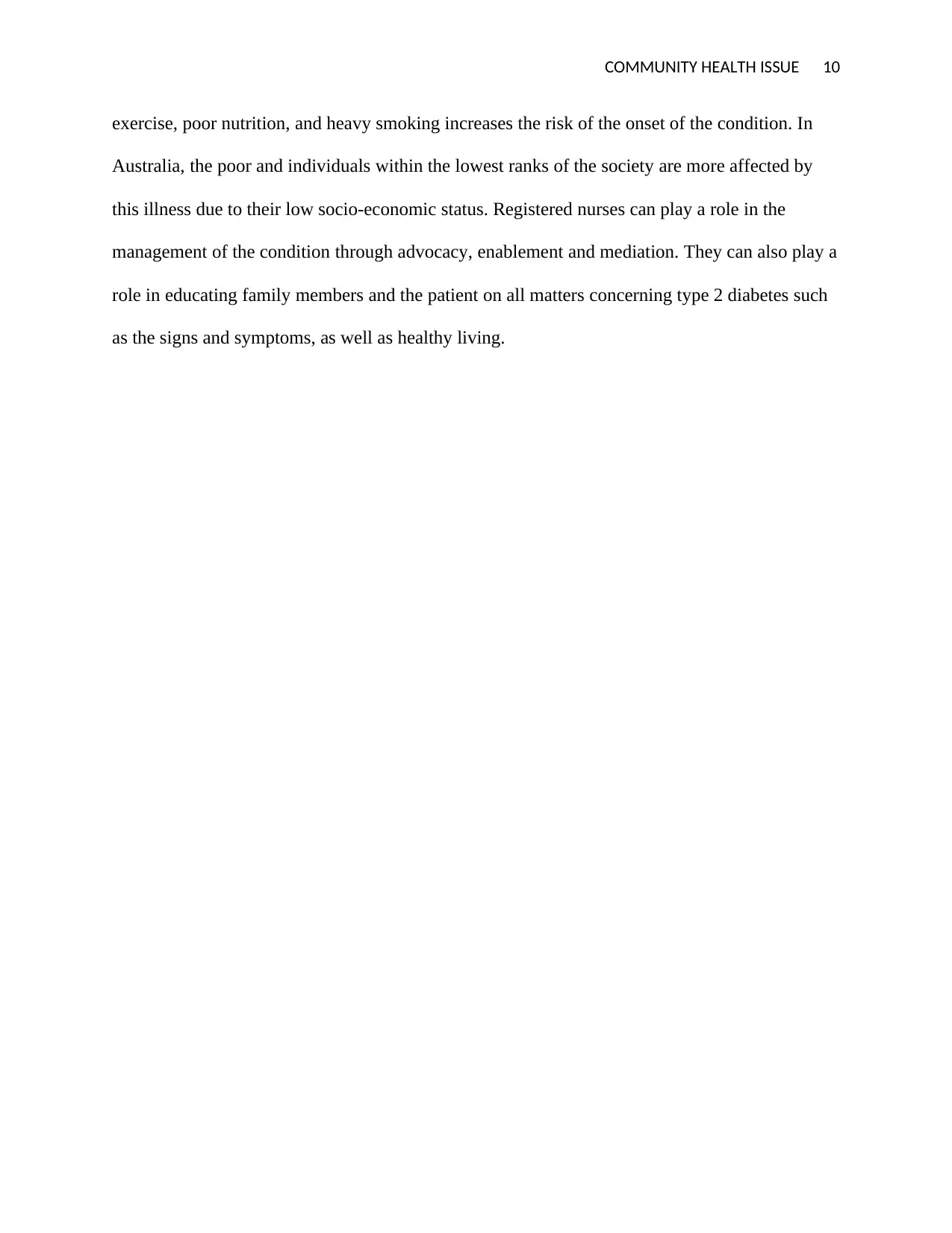
COMMUNITY HEALTH ISSUE 10
exercise, poor nutrition, and heavy smoking increases the risk of the onset of the condition. In
Australia, the poor and individuals within the lowest ranks of the society are more affected by
this illness due to their low socio-economic status. Registered nurses can play a role in the
management of the condition through advocacy, enablement and mediation. They can also play a
role in educating family members and the patient on all matters concerning type 2 diabetes such
as the signs and symptoms, as well as healthy living.
exercise, poor nutrition, and heavy smoking increases the risk of the onset of the condition. In
Australia, the poor and individuals within the lowest ranks of the society are more affected by
this illness due to their low socio-economic status. Registered nurses can play a role in the
management of the condition through advocacy, enablement and mediation. They can also play a
role in educating family members and the patient on all matters concerning type 2 diabetes such
as the signs and symptoms, as well as healthy living.
Paraphrase This Document
Need a fresh take? Get an instant paraphrase of this document with our AI Paraphraser
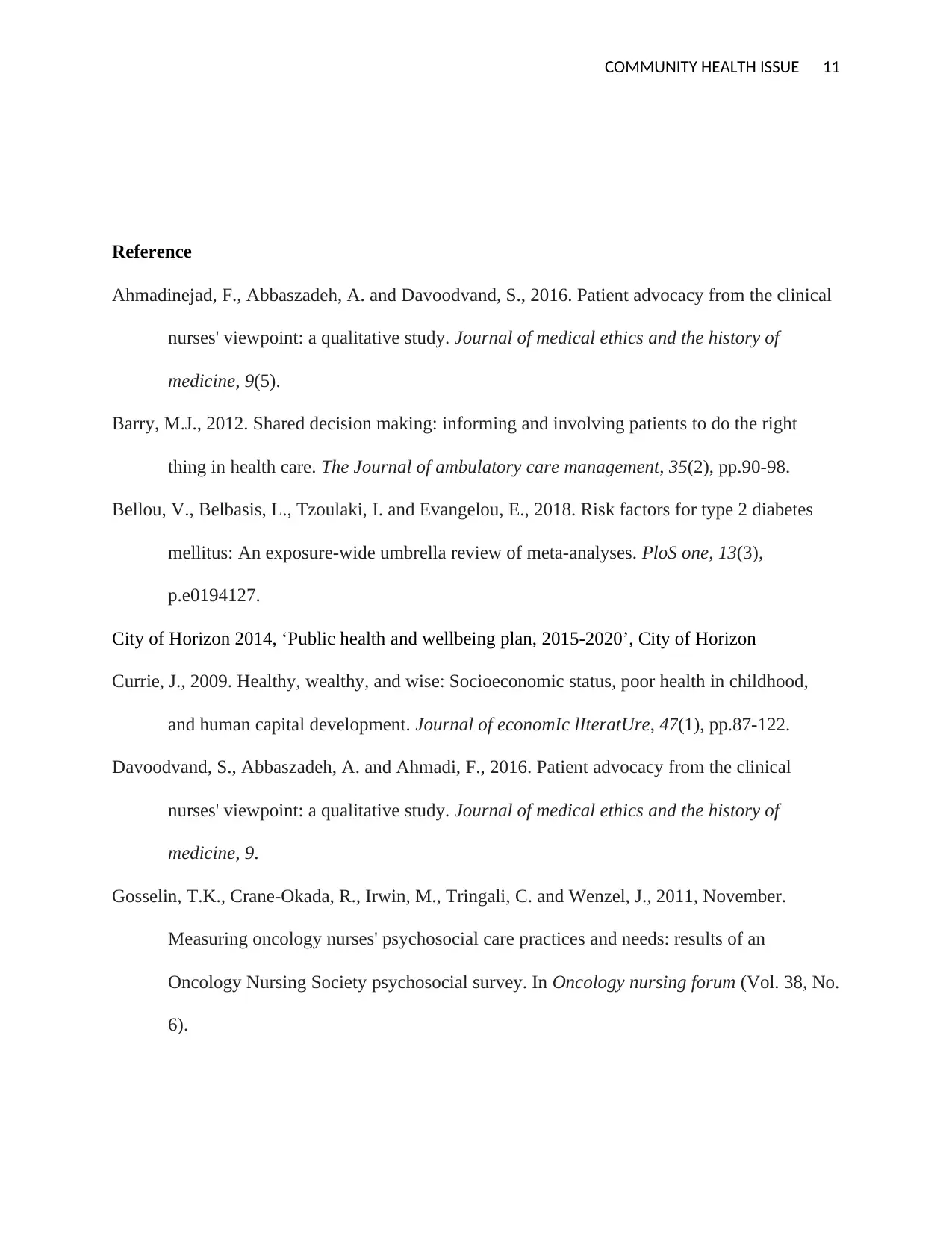
COMMUNITY HEALTH ISSUE 11
Reference
Ahmadinejad, F., Abbaszadeh, A. and Davoodvand, S., 2016. Patient advocacy from the clinical
nurses' viewpoint: a qualitative study. Journal of medical ethics and the history of
medicine, 9(5).
Barry, M.J., 2012. Shared decision making: informing and involving patients to do the right
thing in health care. The Journal of ambulatory care management, 35(2), pp.90-98.
Bellou, V., Belbasis, L., Tzoulaki, I. and Evangelou, E., 2018. Risk factors for type 2 diabetes
mellitus: An exposure-wide umbrella review of meta-analyses. PloS one, 13(3),
p.e0194127.
City of Horizon 2014, ‘Public health and wellbeing plan, 2015-2020’, City of Horizon
Currie, J., 2009. Healthy, wealthy, and wise: Socioeconomic status, poor health in childhood,
and human capital development. Journal of economIc lIteratUre, 47(1), pp.87-122.
Davoodvand, S., Abbaszadeh, A. and Ahmadi, F., 2016. Patient advocacy from the clinical
nurses' viewpoint: a qualitative study. Journal of medical ethics and the history of
medicine, 9.
Gosselin, T.K., Crane-Okada, R., Irwin, M., Tringali, C. and Wenzel, J., 2011, November.
Measuring oncology nurses' psychosocial care practices and needs: results of an
Oncology Nursing Society psychosocial survey. In Oncology nursing forum (Vol. 38, No.
6).
Reference
Ahmadinejad, F., Abbaszadeh, A. and Davoodvand, S., 2016. Patient advocacy from the clinical
nurses' viewpoint: a qualitative study. Journal of medical ethics and the history of
medicine, 9(5).
Barry, M.J., 2012. Shared decision making: informing and involving patients to do the right
thing in health care. The Journal of ambulatory care management, 35(2), pp.90-98.
Bellou, V., Belbasis, L., Tzoulaki, I. and Evangelou, E., 2018. Risk factors for type 2 diabetes
mellitus: An exposure-wide umbrella review of meta-analyses. PloS one, 13(3),
p.e0194127.
City of Horizon 2014, ‘Public health and wellbeing plan, 2015-2020’, City of Horizon
Currie, J., 2009. Healthy, wealthy, and wise: Socioeconomic status, poor health in childhood,
and human capital development. Journal of economIc lIteratUre, 47(1), pp.87-122.
Davoodvand, S., Abbaszadeh, A. and Ahmadi, F., 2016. Patient advocacy from the clinical
nurses' viewpoint: a qualitative study. Journal of medical ethics and the history of
medicine, 9.
Gosselin, T.K., Crane-Okada, R., Irwin, M., Tringali, C. and Wenzel, J., 2011, November.
Measuring oncology nurses' psychosocial care practices and needs: results of an
Oncology Nursing Society psychosocial survey. In Oncology nursing forum (Vol. 38, No.
6).
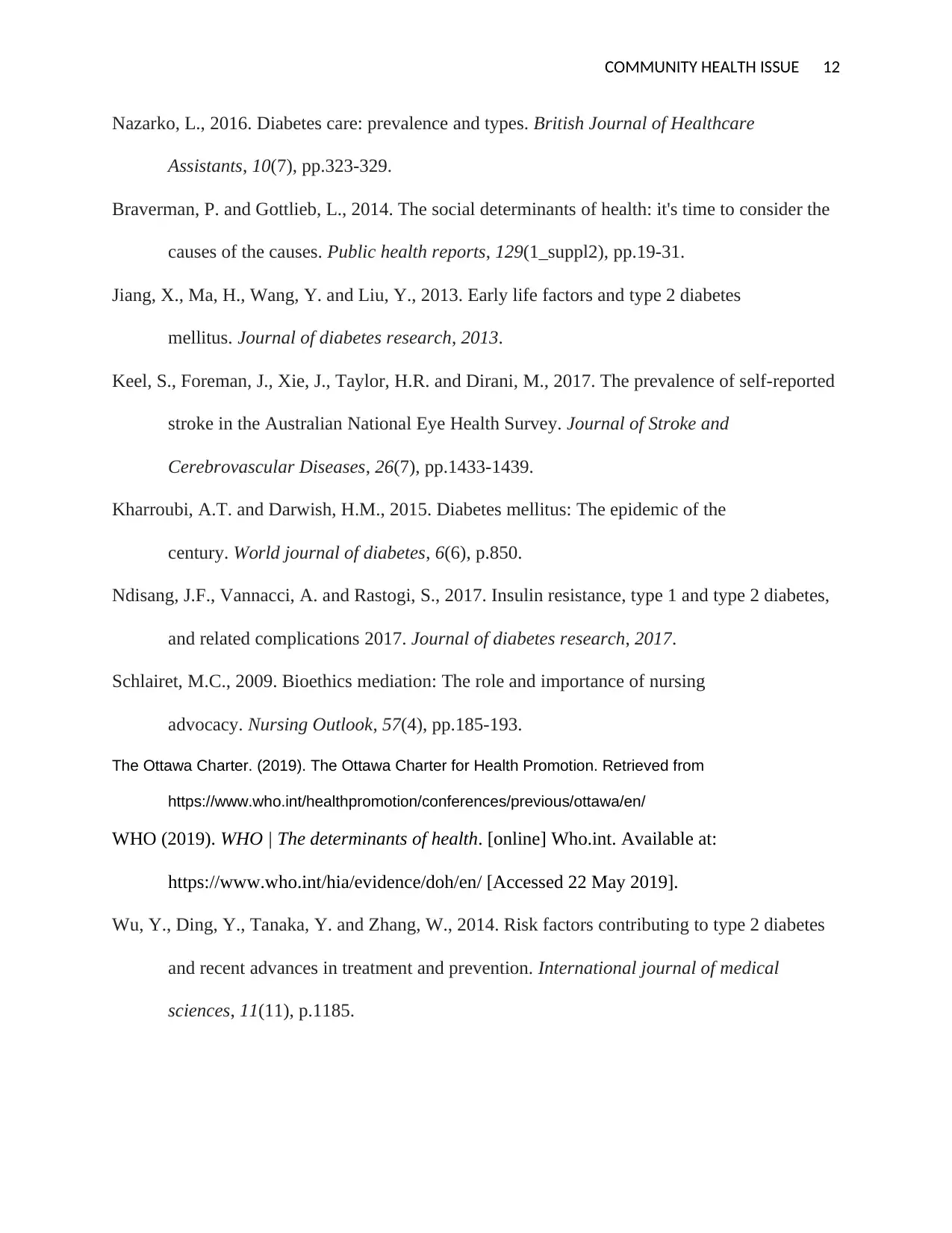
COMMUNITY HEALTH ISSUE 12
Nazarko, L., 2016. Diabetes care: prevalence and types. British Journal of Healthcare
Assistants, 10(7), pp.323-329.
Braverman, P. and Gottlieb, L., 2014. The social determinants of health: it's time to consider the
causes of the causes. Public health reports, 129(1_suppl2), pp.19-31.
Jiang, X., Ma, H., Wang, Y. and Liu, Y., 2013. Early life factors and type 2 diabetes
mellitus. Journal of diabetes research, 2013.
Keel, S., Foreman, J., Xie, J., Taylor, H.R. and Dirani, M., 2017. The prevalence of self-reported
stroke in the Australian National Eye Health Survey. Journal of Stroke and
Cerebrovascular Diseases, 26(7), pp.1433-1439.
Kharroubi, A.T. and Darwish, H.M., 2015. Diabetes mellitus: The epidemic of the
century. World journal of diabetes, 6(6), p.850.
Ndisang, J.F., Vannacci, A. and Rastogi, S., 2017. Insulin resistance, type 1 and type 2 diabetes,
and related complications 2017. Journal of diabetes research, 2017.
Schlairet, M.C., 2009. Bioethics mediation: The role and importance of nursing
advocacy. Nursing Outlook, 57(4), pp.185-193.
The Ottawa Charter. (2019). The Ottawa Charter for Health Promotion. Retrieved from
https://www.who.int/healthpromotion/conferences/previous/ottawa/en/
WHO (2019). WHO | The determinants of health. [online] Who.int. Available at:
https://www.who.int/hia/evidence/doh/en/ [Accessed 22 May 2019].
Wu, Y., Ding, Y., Tanaka, Y. and Zhang, W., 2014. Risk factors contributing to type 2 diabetes
and recent advances in treatment and prevention. International journal of medical
sciences, 11(11), p.1185.
Nazarko, L., 2016. Diabetes care: prevalence and types. British Journal of Healthcare
Assistants, 10(7), pp.323-329.
Braverman, P. and Gottlieb, L., 2014. The social determinants of health: it's time to consider the
causes of the causes. Public health reports, 129(1_suppl2), pp.19-31.
Jiang, X., Ma, H., Wang, Y. and Liu, Y., 2013. Early life factors and type 2 diabetes
mellitus. Journal of diabetes research, 2013.
Keel, S., Foreman, J., Xie, J., Taylor, H.R. and Dirani, M., 2017. The prevalence of self-reported
stroke in the Australian National Eye Health Survey. Journal of Stroke and
Cerebrovascular Diseases, 26(7), pp.1433-1439.
Kharroubi, A.T. and Darwish, H.M., 2015. Diabetes mellitus: The epidemic of the
century. World journal of diabetes, 6(6), p.850.
Ndisang, J.F., Vannacci, A. and Rastogi, S., 2017. Insulin resistance, type 1 and type 2 diabetes,
and related complications 2017. Journal of diabetes research, 2017.
Schlairet, M.C., 2009. Bioethics mediation: The role and importance of nursing
advocacy. Nursing Outlook, 57(4), pp.185-193.
The Ottawa Charter. (2019). The Ottawa Charter for Health Promotion. Retrieved from
https://www.who.int/healthpromotion/conferences/previous/ottawa/en/
WHO (2019). WHO | The determinants of health. [online] Who.int. Available at:
https://www.who.int/hia/evidence/doh/en/ [Accessed 22 May 2019].
Wu, Y., Ding, Y., Tanaka, Y. and Zhang, W., 2014. Risk factors contributing to type 2 diabetes
and recent advances in treatment and prevention. International journal of medical
sciences, 11(11), p.1185.
⊘ This is a preview!⊘
Do you want full access?
Subscribe today to unlock all pages.

Trusted by 1+ million students worldwide
1 out of 12
Related Documents
Your All-in-One AI-Powered Toolkit for Academic Success.
+13062052269
info@desklib.com
Available 24*7 on WhatsApp / Email
![[object Object]](/_next/static/media/star-bottom.7253800d.svg)
Unlock your academic potential
Copyright © 2020–2025 A2Z Services. All Rights Reserved. Developed and managed by ZUCOL.




